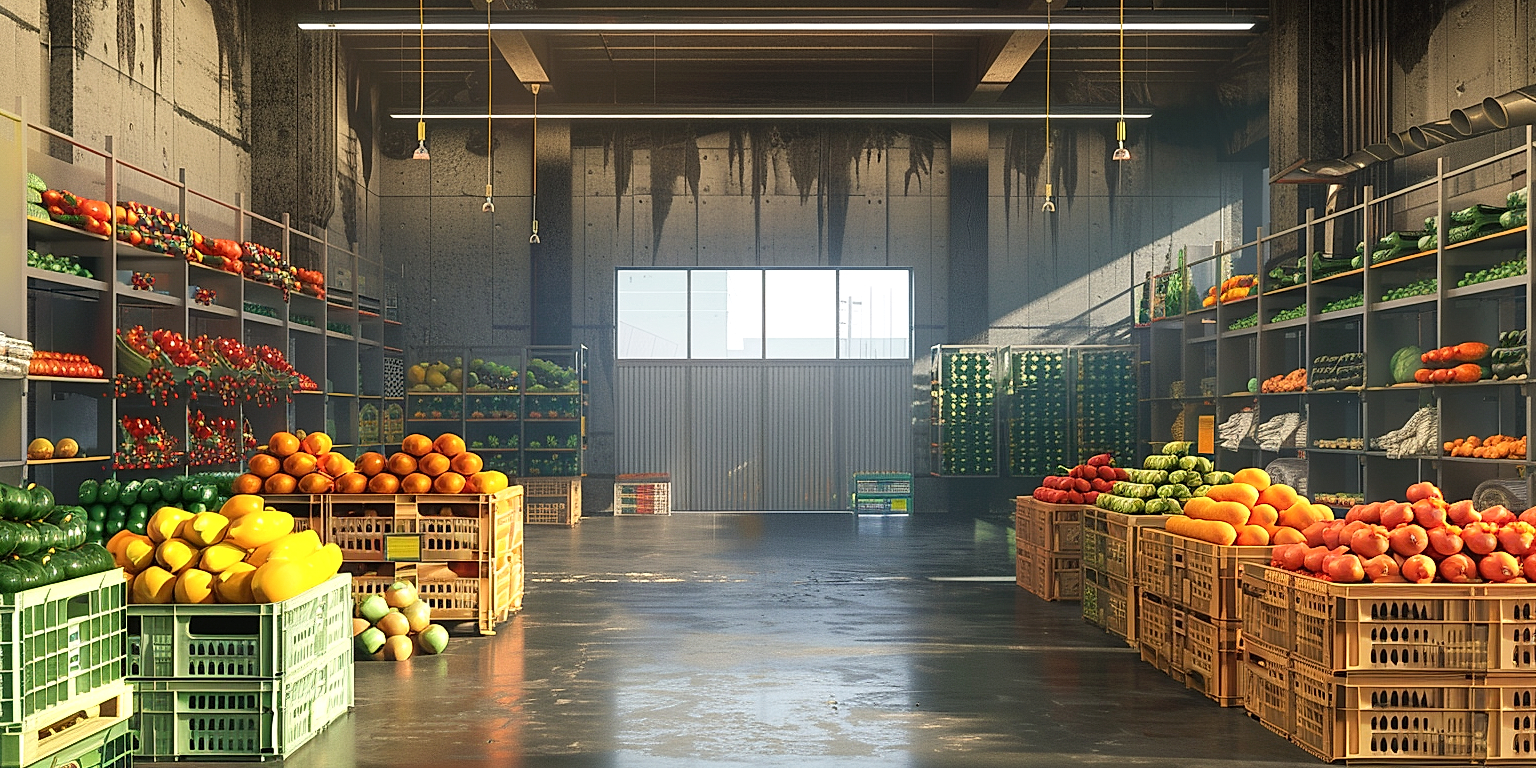Ensuring safety in the workplace is fundamental for any industry, but this is particularly paramount when we delve into the sphere of produce distribution centers.
Operations within these facilities are laden with potential risks that can affect the well-being of its workforce.
From handling equipment, to managing storages laden with perishable items, the activities in these centers carry peculiar hazards.
Concrete steps need to be taken to mitigate these dangers and create a safe environment.
This article explores some indispensable safety practices that could revolutionize the functionality of a produce distribution center.
By adopting these measures, businesses can protect their most valuable resource – their employees.
Workplace Safety Practices For Produce Distribution Centers
1. Regularly sanitize surfaces and equipment.
In a Produce Distribution Center, ensuring the regular sanitization of surfaces and equipment is a critical workplace safety practice.
The frequent cleaning wards off the potential for disease-causing organisms to establish themselves on these surfaces
These organisms pose a significant risk to the health of employees and the safety of the products being handled.
More so, poor sanitation can lead to cross-contamination, where harmful bacteria, viruses, or other microorganisms are transferred from unclean surfaces or equipment to workers, fresh produce, or other surfaces.
To combat this, surfaces and equipment frequently used or touched in the course of work, such as workstations, forklifts, storage crates, and packaging materials, should be sanitized regularly.
In implementing this, the use of antibacterial or disinfectant wipes and spray solutions that eliminate germs effectively is recommended.
Such cleaning agents should also be gentle enough to prevent damage to equipment and ensure no harmful residue is left on the surfaces.
Besides, cleaning schedules should be established with cleaning being done at designated times or after certain activities, like at the start or end of the day, shift changes, or after loading or unloading goods.
Moreover, all workers should have access to cleaning tools, supplies and personal protective equipment that protects them during cleaning.
Training should also be provided on how to clean and sanitize surfaces and equipment effectively and safely.
To ascertain the effectiveness of cleaning practices, regular inspections on cleanliness levels should be made and feedback provided to encourage compliance among workers.
Conversely, in extreme cases where severe contamination is suspected, professional cleaning services may be hired to ensure a thoroughly sanitized environment.
Finally, alongside the sanitization, ensuring good personal hygiene among workers is equally important to prevent the transfer of pathogens to surfaces or equipment.
Thus, regular sanitization not only protects the health of the employees, but also the integrity of the distributed produce and, in turn, the consumers’ health, exemplifying it as a key workplace safety practice.
However, continual review and improvement of the sanitization practices are key to ensure they remain effective in the changing work environment, noting that consistency is the key in sanitation.
2. Use Personal Protective Equipment (PPE)
In the world of produce distribution, ensuring that all employees utilize Personal Protective Equipment (PPE) can significantly contribute towards workplace safety.
The term PPE refers to protective clothing, helmets, gloves, face shields, goggles, facemasks, and/or respirators or other equipment designed to protect the wearer from injury or the spread of infection or illness.
When used properly, PPE can create a barrier between the worker and potential workplace hazards, hence preventing the onset of work-related injuries or illnesses.
Since the nature of tasks in a produce distribution center can expose workers to a wide range of hazards such as chemicals, biohazards, physical elements, electrical hazards, and sharp objects, using appropriate PPE is crucially important.
blockquote { Making the correct PPE choices can help motivate all employees to take an active role in creating a safer work environment. }This comes with an understanding that the type of PPE needed will vary based on different functions within the center. For instance, workers handling heavy equipment may require safety boots, helmets, and gloves, while those working with chemicals may need chemical-resistant gloves and safety goggles.
The key lies in conducting thorough risk assessments to determine the adequate types of PPE for each role.
Besides choosing the right type of PPE, it’s also essential that the equipment fits each worker properly, as ill-fitting gear can potentially cause discomfort, reduce effectiveness, and even increase the risk of injury.
An equally vital aspect is ensuring each worker’s adequate understanding of how to use PPE correctly.
Clear and comprehensive training thus must be provided with regular reminders and updates to address PPE-related practices as they grow more comfortable and familiar with the equipment.
Regular monitoring and enforcement of PPE use is also important, with supervisors setting the example and demonstrating good practice to their teams.
This not only reinforces the significance of PPE, but also helps develop and maintain a strong safety culture within the workplace.
Maintaining a supply of high-quality and clean PPE that is readily available can also make it more likely that workers will use it.
Last, but not least, it’s important that everyone knows when to replace their PPE.
Worn-out or damaged protective equipment can significantly reduce its effectiveness, thereby compromising the user’s safety.
By taking these steps and creating a strong PPE program, produce distribution centers can do their part in fostering a safety-first workplace.
3. Handle Equipment According to Guidelines
Adhering to the correct operation guidelines when handling equipment is a crucial safety practice in any produce distribution center.
Employees must be trained to properly use, handle, and maintain each piece of equipment they encounter.
Failure to do so could lead to accidents or injuries that could have been prevented through appropriate equipment handling.
Every piece of equipment has specific operation guidelines, be it a forklift, conveyor belt, or industrial refrigerator.
By following these guidelines, employees not only protect themselves, but also ensure the longevity of the equipment and the integrity of the produce handled.
For instance, forklift operators must be properly trained and certified to reduce the risk of accidents.
Most of the time, this training will address the proper way to load, operate, and maintain the forklift.
Additionally, equipment should always be inspected before use to ensure it is in good working condition.
If any malfunctions are found, they should be rectified before attempting to operate the equipment.
In some cases, there may be specific protocols in place for emergency situations, such as an equipment malfunction while in use.
Knowing how to react and handle these situations is crucial to maintain safety and minimize potential damage.
Furthermore, employees must be aware of the risks associated with improper handling of equipment.
For instance, if a piece of equipment is misused or mishandled, it could cause severe, potentially fatal injuries.
Given this, frequent refresher courses on equipment handling can be invaluable to reinforce the importance of safety measures in the workplace.
Above all, it is paramount that all employees within a produce distribution center treat equipment handling as a critical aspect of their daily operations and safety precautions.
4. Utilize Proper Lifting Techniques
To maintain a safe workplace environment in Produce Distribution Centers, it is essential to utilize proper lifting techniques.
Regular physical handling of heavy materials can lead to severe health issues, like musculoskeletal disorders, if not performed correctly.
Often, workplace injuries are a result of improper lifting techniques, involving bending, twisting, or overreaching.
Proper lifting techniques can reduce the risk of these injuries, thus promoting a better work environment and overall employee health.
It is crucial to hold the load close to the body during lifting, in order to effectively decrease the pressure on the lower back.
The lifter’s feet should be shoulder-width apart, and their body should be lowered close to the object while bending at the knees, not the waist, during lifting.
Such lifting methods promote good posture and reduce the risk of back pain or injuries.
Actual lifting should be performed using the leg muscles, not back, to avoid unnecessary strain.
Moreover, for larger, heavier loads, team lifting strategies should be employed to ensure safety.
Employees should be encouraged to communicate and coordinate with their coworkers during simultaneous lifting of heavy objects.
Consistently applying these techniques will contribute to better physical health of the employees and significantly reduce work-related injuries.
Training on how to use these techniques should also be reinforced occasionally, to ensure that employees do not drift back to their old, unsafe practices.
Clear diagrams and visual aids demonstrating safe lifting techniques can also be posted in the workplace to remind workers continuously.
Produce distribution centers are typically bustling workplaces, heavy on physical labor hence, the importance of using correct lifting methods cannot be overstated.
By prioritizing safety through proper lifting techniques, work-related injuries can be significantly reduced.
5. Maintain Clear, Unobstructed Pathways
Maintaining clear, unobstructed pathways is a critical workplace safety practice for any produce distribution center.
It ensures safe navigation throughout the facility for employees and can significantly reduce the risk of accidents.
This practice not only applies to walkways and hallways but also to access points and loading docks. Proper organization and cleanliness in these areas are vital.
Machinery, equipment, tools, and produce must be placed in designated locations, away from aisles or pathways.
This helps to eliminate potential hazards that could lead to slips, trips or falls.
It’s essential to maintain visibility in all areas to avoid collisions or accidents.
Good lighting and clear signage indicating pathways are also required to maintain safety.
Timely removal of debris or spillages that could obstruct a pathway is essential.
This includes falling produce, packaging materials or spilled liquids.
Regular inspections should be performed to ensure pathways are kept clear and safe.
Obstructions can slow down workflow and cause inefficiencies apart from posing a safety risk.
If pathways are obstructed it can prevent safe evacuation of employees in case of an emergency.
This could have serious consequences in a potential life-threatening situation.
Reiteration of the importance of clear pathways through safety briefings or training sessions can assure adherence by all employees.
As such, maintaining clear, unobstructed pathways should be treated as a priority and not as an afterthought.
Efficient planning and adhering to safety standards can help establish clear, safe pathways.
6. Conduct Routine Safety Inspections.
The practice of conducting routine safety inspections is an integral part of maintaining the safety and integrity of produce distribution centers.
These inspections are vital to the detection of potential hazards before they can result in accidents or injuries.
Regular inspections allow for the early identification of risks in the workplace, including both tangible hazards, such as faulty equipment, and intangible ones, such as poor work practices.
This practice is not merely about maintaining compliance with safety regulations; rather, it is about establishing a culture of safety within the organization.
The importance of routine safety inspections can not be understated: they are a crucial factor in preventing workplace accidents.
Regular inspections allow for the early identification of risks in the workplace, including both tangible hazards, such as faulty equipment, and intangible ones, such as poor work practices.
During these inspections, it is essential to assess all areas of the workplace, from the warehouse floor to the office space.
Attention should be focused on areas where accidents are most likely to occur, such as loading dock areas, and places where heavy machinery or equipment is used.
In addition to physical hazards, inspections should also assess factors such as lighting, ventilation, temperature, and noise levels.
Many potential hazards, like flammable materials, can be mitigated by proper storage, maintenance, and handling practices.
The inspection process should involve individuals from various levels of the organization, creating a team approach to safety and fostering a shared responsibility for maintaining a safe working environment.
It is crucial to fully document the findings of each safety inspection, noting both areas of compliance and areas necessitating improvement or corrective action.
An effective inspection will not only identify problems but will also note what is working well and which protocols are being effectively followed.
Post-inspection, a meeting should be held with relevant team members to discuss findings and devise a plan to address any discovered hazards or safety concerns.
Ultimately, the goal is to create a proactive safety culture within the produce distribution center, where safety is not viewed as a chore, but as a core business function integral to success.
7. Provide Safety Training for Employees
One of the integral aspects of maintaining workplace safety in a produce distribution center is to provide comprehensive safety training for all employees.
Without proper training, even the most diligent worker may unknowingly contribute to a hazardous environment.
It is therefore vital to ensure that our personnel are adequately educated in the correct protocols and procedures in relation to safety.
Employee training should be continuous and cover diverse aspects, including the correct way of handling equipment, interpreting safety signs, understanding the potential risks, and knowing what to do in an emergency scenario.
Each worker should be made aware of the potential risks associated with their tasks and how to prepare for or prevent accidents from happening.
Moreover, special focus should be placed on training employees on how to operate machinery or equipment they are tasked to handle.
Incorrect handling or operation can not only lead to damage to the equipment but can also pose severe safety threats to employees.
Employee training for safety should not be a one-time event.
Regular refresher courses and training sessions should be implemented to ensure that safe handling practices and protocols are always at the forefront of our workers’ consciousness.
The training should also cover procedures on how to respond to emergency situations.
Emphasis should be given on first aid applications, evacuation plans, and the use of safety equipment like fire extinguishers and emergency exits.
By doing so, we not only create a safer working environment but also use these trainings as an opportunity to demonstrate our commitment towards our employees’ safety and well-being.
Another important aspect that should be covered in the safety training is the correct use of personal protective equipment (PPE).
It is fundamental that every worker is aware about how to properly wear, remove, and dispose PPE to protect themselves from risks.
An effective safety training program must also encourage employees to report any safety concerns or incidents.
Such a system of open communication can help management promptly address any potential hazards and maintain a safer working environment.
The Bottom Line
Maintaining safety in the workplace clearly requires a multi-pronged approach.
Cleaning and sterilizing surfaces and equipment consistently is crucial, as is the correct use and handling of personal protective equipment and work tools.
Likewise, safe physical actions such as using proper lifting techniques and keeping clear pathways help to prevent injuries.
Conducting frequent safety checks ensures that any issues are promptly addressed, while providing ongoing training helps to keep all employees up-to-date on best safety practices.
Clearly, the key to a safer working environment lies in being proactive, educated, and diligent in these areas.




